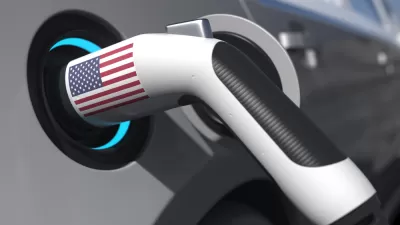Communities of color are already being left behind as the nation prepares the infrastructure for an electric future.

The transition to electric vehicles (EVs) is revving up, thanks to federal incentives and the recent U.S. Department of Transportation approval for all 50 states to start construction on a national network of EV charging stations. This investment is key, but so is ensuring we don’t leave behind communities of color as we race toward our EV future.
The Southeast is on the verge of opening new lanes of success in the EV revolution—think Volkswagen in Tennessee, Rivian and Hyundai in Georgia, Mercedes in Alabama, Ford in Kentucky, BMW in South Carolina, and Tesla in Texas. These investments and the jobs they will bring to the Black Belt are a welcome benefit of the bipartisan Infrastructure Investment and Jobs Act (IIJA).
However, there are danger signs that history could replay itself without robust oversight to ensure that the billions in new federal and private cash deliver on the promises of equity going forward, as well as restorative justice for past harms.
As a Black millennial and evangelical, I believe the biblical call for justice requires an honest assessment of the climate crisis, including the admission that communities of color are disproportionately harmed, and all too often silenced in the quest for climate solutions. The prophets warn us from lightly dressing the wounds of those harmed, while we proclaim “peace, peace,” when there is no peace.
We cannot “love our neighbor as yourself,” if our neighbors are written out of the public good narrative, shortchanged in resource allocation and disproportionately suffer harm without seeing their fair share of economic benefit.
At first glance, the U.S. Department of Transportation’s approach to not “exacerbate” inequalities look praiseworthy. The IIJA provides $7.5 billion to fund EV charging, including $2.5 billion for a grant program for underserved and overburdened communities. It even makes a certain type of economic and efficiency sense to build this Alternative Fuel Corridor on the back of the interstate highway system.
But we must remember that the history of U.S. highways are fraught with discrimination. The 1956 Federal Aid Highway Act too had a vision of modernizing traffic infrastructure. Millions of dollars were spent directly, and oftentimes purposefully, ripping apart communities of color to enable white residents to speed to newly created suburban and exurban homogeneous enclaves. As Princeton University historian Kevin Kruse points out, “so-called urban renewals and the new interstates only helped speed white flight from the city,” with desegregation imminent, and civil rights on the horizon in the ’60s.
Consider the ramifications on public services, public goods, and the tax base in cities like my hometown of Atlanta, where infrastructure serves as a literal and symbolic dividing line between Black and white communities. As many as 60,000 whites left Atlanta for the suburbs in the 1960s and another 100,000 in the 1970s.
To be sure, the 2022 National Electric Vehicle Infrastructure Formula Program guidance includes equity considerations that should be commended. This includes a recognition that the “unequal distribution of benefits from the transportation and energy systems has prevented disadvantaged communities and minority-owned and women-owned businesses from realizing equitable benefits.”
Yet the picture painted by the “Electric Vehicle Charging Justice Map” shows there is a massive hill to climb. Across America, EV charging stations in communities of color are generally fewer than in areas that are predominantly white and affluent. If we are not diligent in our oversight targeting communities left behind, we will multiply the brokenness.
This isn’t a North/South, blue/red or Democrat and Republican issue either.
A recent study out of California, a leader in the EV transition, has found that even in this early stage of the transition, Black and Latino communities have less access to public chargers. In Chicago, most charging stations were in just three communities, affluent and mostly white, according to the Energy News Network. More than half the city had no public charging stations at all.
America needs to repent for our past infrastructure sins and have an honest assessment, including an admission that communities of color are already disproportionately left behind with our current climate solutions. When we only pay lip service and pass by communities of color in our conversations, they disproportionately suffer from not receiving the economic benefit we are promising.
If we accelerate our transition to EVs without meaningfully, and continually, serving communities of color first, our policies will continue to supercharge racial and environmental injustice and fall short of what it takes to protect all Americans.
Marqus Cole is the director of church and community engagement for the Evangelical Environmental Network. He is also a Public Voices Fellow with The OpEd Project in partnership with the Yale Program on Climate Change Communication.

Alabama: Trump Terminates Settlements for Black Communities Harmed By Raw Sewage
Trump deemed the landmark civil rights agreement “illegal DEI and environmental justice policy.”

Planetizen Federal Action Tracker
A weekly monitor of how Trump’s orders and actions are impacting planners and planning in America.

The 120 Year Old Tiny Home Villages That Sheltered San Francisco’s Earthquake Refugees
More than a century ago, San Francisco mobilized to house thousands of residents displaced by the 1906 earthquake. Could their strategy offer a model for the present?

BLM To Rescind Public Lands Rule
The change will downgrade conservation, once again putting federal land at risk for mining and other extractive uses.

Indy Neighborhood Group Builds Temporary Multi-Use Path
Community members, aided in part by funding from the city, repurposed a vehicle lane to create a protected bike and pedestrian path for the summer season.

Congestion Pricing Drops Holland Tunnel Delays by 65 Percent
New York City’s contentious tolling program has yielded improved traffic and roughly $100 million in revenue for the MTA.
Urban Design for Planners 1: Software Tools
This six-course series explores essential urban design concepts using open source software and equips planners with the tools they need to participate fully in the urban design process.
Planning for Universal Design
Learn the tools for implementing Universal Design in planning regulations.
Clanton & Associates, Inc.
Jessamine County Fiscal Court
Institute for Housing and Urban Development Studies (IHS)
City of Grandview
Harvard GSD Executive Education
Toledo-Lucas County Plan Commissions
Salt Lake City
NYU Wagner Graduate School of Public Service





























